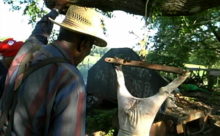Stan Woodward on the Making of The Morris Chronicle
Written by Woodward to supplement his 2015 interview with Saddler Taylor and Tom Davenport.
In The Morris Chronicle documentary, I discover an aged sharecropper-turned-"keeper-of-the-keys" of the Big House who enables a unique understanding of what makes the South the South. Morris is a legendary "hog man" who raises hogs for use in barbecuing. He feeds them on the usual hog food colloquially known as "slop" made up of a mix of food leftovers collected from his and nearby families. But when a customer calls and sets a date for a barbecue, Morris sets aside a hog and feeds it pure corn for three weeks to "clean him out" and purify the meat. Considered a master at this trade, I had the opportunity to document Morris from the setting aside stage through the process of the hog killing, skinning and breaking the hog down into separate parts prior to the barbecuing process. Morris carried this out with his wife, his son and a friend who was an expert butcher.
I met Morris in 2003 in the process of conducting field research and shooting the documentary on Barbecue and Homecooking, made with a grant from the South Carolina Department of Parks, Recreation and Tourism. I was funded to make a film for the Region III SC National Heritage Corridor that enabled tourists to directly experience the folklife of South Carolina. I knew from growing up and visiting my Dad's family as a child in Barnwell County, that this was a region in which the tradition of cooking shade-tree barbecue by farmers seeking to supplement their income during hard times had led to the establishment of legendary barbecue restaurants still operating in the state. I proposed that this tradition was so deeply rooted in Barnwell and surrounding counties that each one was family-owned, with current pit-men having ancestral ties to the originators of the barbecue. They would be keeping alive the tradition's cooking method, recipes for barbecue sauce, and "secret ingredients devised by the original 'pit-men.'" "Visitors," I stated in the grant, "who were customers at these dining sites would find themselves immersed in the midst of the folklife of the region with the opportunity to sit and eat with local 'regulars' and converse with the owners about their tradition."
With the grant I travelled the four adjacent counties located in the Region III S.C. National Heritage Corridor and located diners and "meat-'n-three" restaurants and barbecue eateries where I could authenticate cooks in charge of the kitchens or pit-masters in charge of the barbecue preparation as folk-heritage foodways artisans. These were people who were maintaining and passing down methods and recipes learned directly under elder master cooks (mothers, aunts, and grandmothers in the case of the "meat 'n threes" and buffet restaurants), and fathers, uncles, or grandfathers (in the case of barbecue pit men). We identified these practitioners as folk-heritage foodway artisans according to this definition of folklife: the traditions, activities, skills, and products produced by a particular group of people who have informally learned their skills by practice, learning techniques from elders that they then pass along to the next generation.
Through an acquaintance during this process, I ran across one of the last remaining barbecue pit-man in the Edisto River region who still cooks by hand in the old-fashioned Springfield, S.C., style. At first meeting, when Morris Peeples welcomed me to his sharecropper cottage, we struck up a friendship that opened into a two-year opportunity to tell this unique Southern Americana story. Morris was a patriarch and looked upon in his community as a man of supreme wisdom, both in life and in the agrarian knowledge that he used to manage the land of many area land-owners. Over the two years of shooting, I captured the story of Morris as the embodiment of the very special relationship of an African-American ex-sharecropper to the land he grew up on and to the white land-owner's estate known as the Hatiola plantation. I was able to document the inside story of how Morris, the son of his slave father who worked as foreman on the Hatiola Plantation, had become endeared to its owner and to the owner's son who inherited Hariola and restored it to be suitable for a hunters' club. With help from the members, the run-down Hatiola Plantation "big house" became a hunt-club house. Morris was beloved by these men and not only was provided membership, but held the keys to Hatiola which he now managed.
At the end of production this film was premiered in honor of Morris at the Hatiola Hunt Club. This occurred two years before Morris died.
